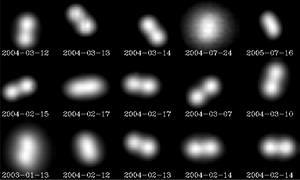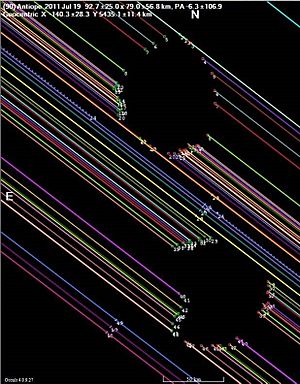90 Antiope facts for kids
90 Antiope is a special space rock called an asteroid. It was first discovered on October 1, 1866, by a scientist named Robert Luther. It was the 90th asteroid ever found! Antiope is named after a character from Greek mythology, but scientists aren't sure if it's named after Antiope the Amazon warrior or Antiope, the mother of two heroes, Amphion and Zethus.
This asteroid travels in the outer part of the main asteroid belt, which is a big area between Mars and Jupiter where many asteroids orbit the Sun. Antiope is part of a group of asteroids known as the Themis family. Like many objects in this area, it looks dark because it's made of a material called carbonaceous chondrite, which is a type of rock that contains carbon.
Scientists have watched Antiope pass in front of stars (this is called an occultation) nine times since 1988. These observations help them learn more about the asteroid.
A Double Asteroid!
The most amazing thing about Antiope is that it's not just one asteroid, but two! These two asteroids are almost the same size, making it a true "double" asteroid. The difference in their weight is very small, less than 2.5%.
Scientists found out it was a double asteroid on August 10, 2000. They used a special telescope called the Keck Telescope in Hawaii, which has advanced technology to see very clearly in space. The second asteroid is officially called S/2000 (90) 1.
Each of the two asteroids is about 86 kilometers (about 53 miles) wide. Their centers are only about 170 kilometers (about 105 miles) apart. This means the space between them is only about 60 kilometers (about 37 miles)!
The two asteroids orbit around a shared point in space, which is like their balance point. It takes them about 16.5 hours to complete one orbit around each other. Every few years, they pass in front of each other when viewed from Earth. By studying their orbit and size, scientists can figure out how heavy and dense these asteroids are.
| Discovery | |
|---|---|
| Discovered by | W. J. Merline, L. M. Close, J. C. Shelton, C. Dumas, F. Menard, C. R. Chapman, and D. C. Slater |
| Discovery date | August 10, 2000 |
| Designations | |
| Main belt (Themis family) | |
| Orbital characteristics | |
| 171 ± 1 km | |
| Eccentricity | 0.01 ± 0.02 |
| 0.687713 ± 0.00004 d (16.5051 ± 0.0001 h) | |
|
Average orbital speed
|
18.0 m/s |
| Satellite of | Binary with 90 Antiope |
| Physical characteristics | |
| Dimensions | 86±1 km |
| Mass | ~ 8.1−8.5 ×1017 kg |
|
Equatorial escape velocity
|
variable; ~ 35−40 m/s |
| 0.687 d (16.50 h) | |
| 9.02 | |

Antiope Douplet by VLT
|
|||||||||||||
| Discovery [1] | |||||||||||||
|---|---|---|---|---|---|---|---|---|---|---|---|---|---|
| Discovered by | Robert Luther | ||||||||||||
| Discovery date | October 1, 1866 | ||||||||||||
| Designations | |||||||||||||
| 1952 BK2 [2] | |||||||||||||
| Main belt (Themis family) |
|||||||||||||
| Orbital characteristics [3] | |||||||||||||
| Epoch August 18, 2005 (JD 2453600.5) |
|||||||||||||
| Aphelion | 545.753 Gm 3.648 AU |
||||||||||||
| Perihelion | 398.502 Gm 2.664 AU |
||||||||||||
| 472.128 G m 3.156 AU |
|||||||||||||
| Eccentricity | 0.156 | ||||||||||||
| 2047.856 d (5.61 a) | |||||||||||||
|
Average orbital speed
|
16.66 km/s | ||||||||||||
| 348.378° | |||||||||||||
| Inclination | 2.220° | ||||||||||||
| 70.235° | |||||||||||||
| 242.480° | |||||||||||||
| Physical characteristics | |||||||||||||
| Dimensions | 86±1 km (each component) |
||||||||||||
| Mass | 8.3×1017 kg (whole system) ~ 4.1−4.2 ×1017 kg (components) |
||||||||||||
|
Mean density
|
1.25 ± 0.05 g/cm³ (each) | ||||||||||||
|
Equatorial surface gravity
|
variable; ~ 0.03−0.04 m/s² | ||||||||||||
|
Equatorial escape velocity
|
variable; ~ 35−40 m/s | ||||||||||||
| 0.687 d (16.50 h). | |||||||||||||
| 0.060 | |||||||||||||
|
|||||||||||||
| C | |||||||||||||
| 8.27 (together) 9.02 (each component) |
|||||||||||||
See also
 In Spanish: (90) Antiope para niños
In Spanish: (90) Antiope para niños


